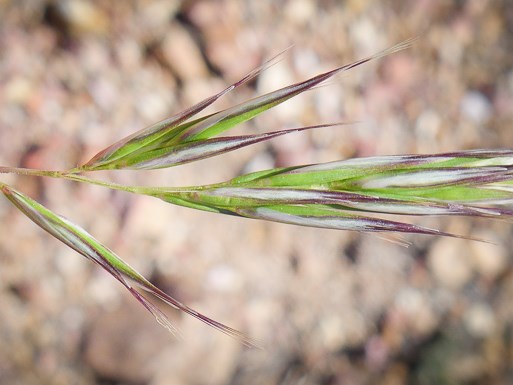Created on: Friday, Aug 12th, 2016
Victoria: http://vro.agriculture.vic.gov.au/dpi/vro/vrosite.nsf/pages/water_sss_co...
GGNRA Newsletter: https://www.google.com/url?sa=t&rct=j&q=&esrc=s&source=web&cd=2&cad=rja&...
PlantNet: http://plantnet.rbgsyd.nsw.gov.au/cgi-bin/NSWfl.pl?page=nswfl&lvl=sp&nam...
Jepson eFlora: http://ucjeps.berkeley.edu/eflora/eflora_display.php?tid=80883
Correspondence from Eric Wrubel, September 6, 2016 copied below:
Rytidosperma caespitosum is abundant along road shoulders and utility corridors on Sweeney Ridge and in fuelbreaks on adjacent SFPUC lands. On Golden Gate NRA lands, we have mapped 29 gross acres, and 1.2 net acres, mostly in linear distributions along roads. There is probably an equal or greater amount on the adjacent SFPUC lands. I am cc'ing Don Thomas, the SFPUC IPM specialist, who may know more about the distribution on their lands.
R. caespitosum, and the closely related R. penicillatum are effective colonizers after disturbance, and dense populations can inhibit colonization by other perennial grasses and forbs through a buildup of thatch, especially with continued disturbances such as mowing or grazing. These two species are clearly spread by mowing, and can form long, linear populations along transit corridors. They can be spread away from roads and trails by grazing and wildfire (fire fighting activites).
I would say that with disturbance, both species can displace native plants and dominate communities through rapid colonization and inhibition. I have not yet seen much evidence of this species colonizing undisturbed native vegetation. However, wildfires are part of the natural disturbance regime where R. caespitosum occurs, and I would expect to see a dramatic expansion of this species following a wildfire, where there is adequate propagule pressure. This is what happened with R. penicillatum at Point Reyes, where it now infests hundreds of acres in the footprint of the Vision Fire, and after a fire at POST Cloverdale Ranch in San Mateo Co. (http://calphotos.berkeley.edu/cgi/img_query?enlarge=0000+0000+0408+1847 ).
Reviewed by Eric Wrubel.
- < 13 : accept (low risk of invasiveness)
- 13 - 15 : evaluate further
- > 15 : reject (high risk of invasiveness)

